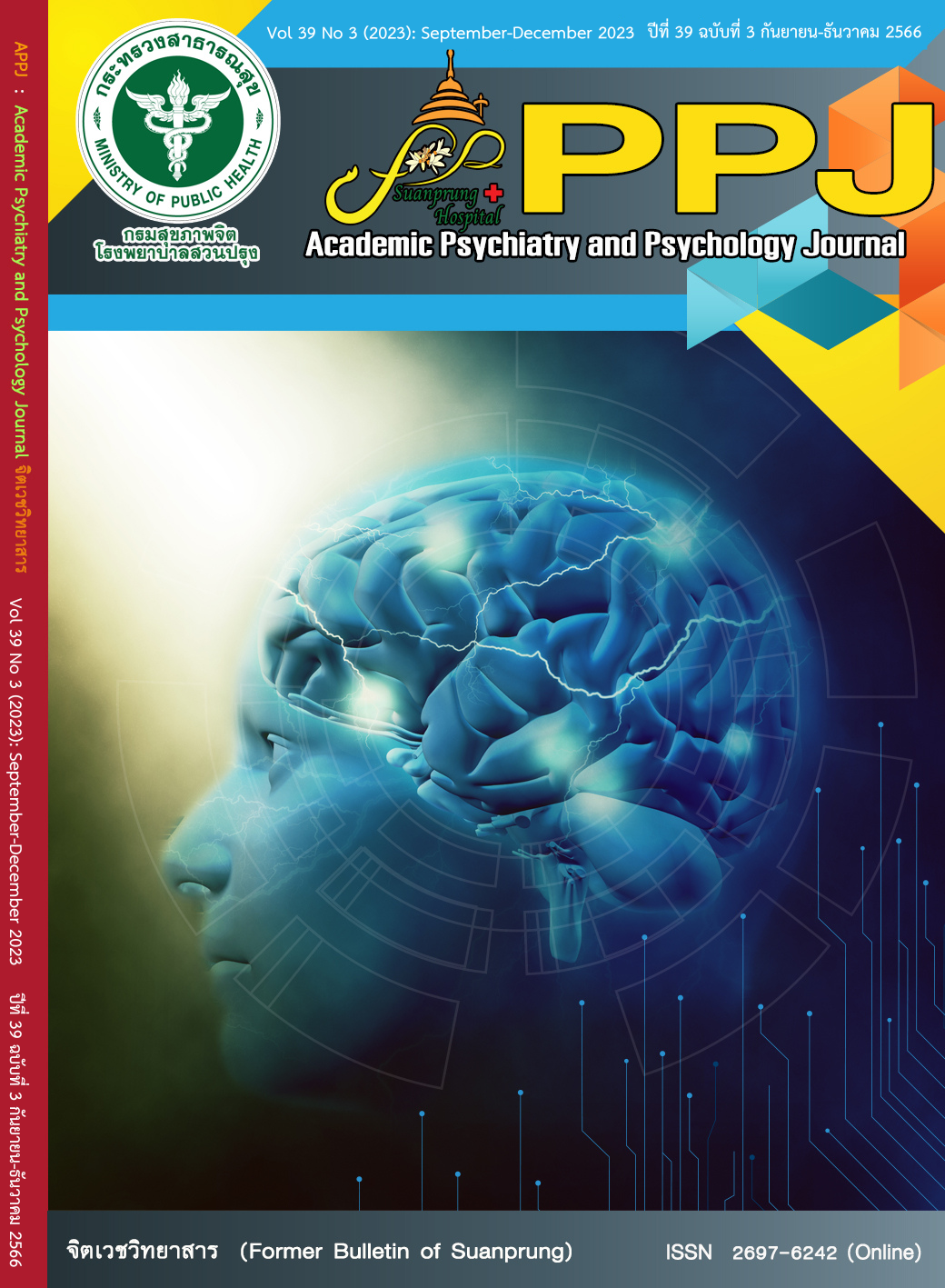Psychometric Properties of Academic Burnout Syndrome Scale Among University Students
Main Article Content
Abstract
Objective: The purpose of this study was to study and develop the Psychometric burnout scale in university students, analyzing quantitative data by content analysis and using the model of Maslach burnout inventory in university students.
Materials and Methods: It consisted of 26 items and was content-validated by five experts. Research tools were used with an experimental group of 37 students to analyze the reliability and discrimination. Subsequently, a confirmatory factor analysis was conducted with 484 students from Chiangmai University in three fields: Health Science, Science and Technology, and Liberal Arts and Social Sciences, from December 2022-January 2023.
Results: The content validity index test by CVI = 0.86 and was used to test the burnout among university students. The reliability of the whole measuring questionnaire had an alpha coefficient of 0.918. When individual components were taken into consideration, it was found that emotional exhaustion = 0.807, cynicism = 0.777, and reduced academic efficacy = 0.915. From the analysis of discrimination power, it was found that the Pearson correlation coefficient was between 0.029 – 0.766. The structural equation for validity using factor analysis confirmed the fit with the empirical data, as indicated by the following statistical values c2 = 251.753, df = 217, c2 /df = 1.16, p-value = 0.0528, CFI = 0.994, TLI = 0.991, RMSEA = 0.018, SRMR = 0.029.
Conclusion: The measurement tool for assessing burnout among university students is consistent, content-valid, and has structural correctness. Therefore, it has good psychological measurement properties.
Article Details

This work is licensed under a Creative Commons Attribution-NonCommercial-NoDerivatives 4.0 International License.
บทความหลังผ่านการปรับแก้จากกองบรรณาธิการแล้ว เป็นลิขสิทธ์ของวารสารจิตเวชวิทยาสาร โรงพยาบาลสวนปรุง กรมสุขภาพจิต กระทรวงสาธารณสุข ห้ามเผยแพร่เพื่อประโยชน์ทางการค้าโดยไม่ได้รับอนุญาต แต่อนุญาตให้เผยแพร่บทความดังกล่าวเพื่อประโยชน์ทางการศึกษาแก่ประชาชนทั่วไป ทั้งนี้กองบรรณาธิการไม่จำเป็นต้องเห็นด้วยกับบทความหรือข้อคิดเห็นใดๆ ที่ปรากฏในวารสารสวนปรุง
References
Maslach, C., & Leiter, M.P. Understanding the burnout experience: recent research and its implications for psychiatry. World Psychiatry. Psychology Department, University of California at .Berkeley 2016;16:103-111.
Chaiporn Pongpisanrat. Learning Burnout: An Inevitable Circumstances.Journal of Education 2564;15:8-15.
Kristanto, T., Chen, W.S., & Thoo, Y.Y.. Academic burnout and eating disorder among students in Monash University Malaysia. Eating Behaviors 2016;22:96-100.
Korket Taikerd, Krongkwan Ruaman, Nirucha Preechalertsilp, Winitra Nuallaong, Panadda Rojpibulsathit. Prevalence and burnout syndrome Pre-clinical medical students Thammasat University. Thammasat Medical Journal 2562;61:127-138.
Miguel Angel Simancas-Pallares, Natalia Fortich Mesab, Farith Damián González Martínez.Validity and internal consistency of the Maslach Burnout Inventory in dental students fromCartagena, Colombia. Revista Colombiana de Psiquiatría. 2016;46-(2):103-109.
Schaufeli WB, Hu Q. The Factorial Validity of the Maslach Burnout Inventory Student
Survey in China. Psychological Reports. 2009;105:394-408.
Campos, J. A., & Maroco, J. (2012). Adaptação transcultural Portugal-Brasil do
Inventário de Burnout de Maslach para estudantes [Maslach Burnout Inventory - Student Survey: Portugal-Brazil cross-cultural adaptation]. Revista de saude publica, 46(5), 816–824. https://doi.org/10.1590/s0034-89102012000500008
Schaufeli WB, Martinez IM, Pinto AM, Salanova M, Bakker AB. Burnout and engagement
in university students: a cross-national study. J Cross Cult Psychol. 2002;33(5):464-81. DOI:10.1177/0022022102033005003
Hu, Q., & Schaufeli, W. B. (2009). The factorial validity of the Maslach Burnout
Inventory-Student Survey in China. Psychological reports, 105(2), 394–408.
https://doi.org/10.2466/PR0.105.2.394-408
Wickramasinghe, N.D., Dissanayake, D.S. & Abeywardena, G.S. Validity and reliability
of the Maslach Burnout Inventory-Student Survey in Sri Lanka. BMC Psychol 6, 52
(2018). https://doi.org/10.1186/s40359-018-0267-7
Hair, J.F., Anderson, R.E., Tatham, R.L., & Black, W.C. Multivariate data analysis.
th ed. New Jerse: Prentice Hall; 1998.
Maslach, Schaufeli, & Leiter. Job Burnout. Psychology Department, University of
California, Berkeley California 2001;51:394-422.
Maneeratsami Pattanasombutsook. Validation of Nursing Research Reports and Proper
Use of Social Science Research Instruments in Publishing. The Southern College
Network Journal of Nursing and Public Health 2012;2:189-204.
Boonjai Srisatidnarakul. Development and Validation of Research Instruments:
Psychometric Properties. Bangkok: Chulalongkorn University printing house; 2555.
Hair, J.F., Anderson, R.E., Tatham, R.L., & Black, W.C. Multivariate data analysis.
th ed. New Jerse: Prentice Hall; 1998.
Muthén, L. K., & Muthén, B.O. How to use a Monte Carlo study to decide on sample
size and determine power. Structural equation modeling 2002;9:599-620.
Nonglak Wichayachai. Confirmatory factor analysis. Journal of Research and Curriculum
Development 2555;2(1):68-74.
Kline RB. Principles and practice of structural equation modeling. 4th ed. New York:
Guilford publications; 2016.
Chaiyan Sakulsriprasert. Confirmatory factor analysis. Journal of Clinical Psychology.
;44(1):1-16.
Diamantopoulos A, Siguaw JA. Introducing LISREL. London: Sage Publications; 2000.
Jingcheng Shi, Xiankun Mo, Zhenqiu Sun. Content validity index in scale development.
Zhong Nan Da Xue Xue Bao Yi Xue Ban 2012;37:152-5.
Papungkorn Inkaew. Introduction to Data Science. 1 Chiang Mai: The document printing
unit center Faculty of Science Chiang Mai University; 2564.

